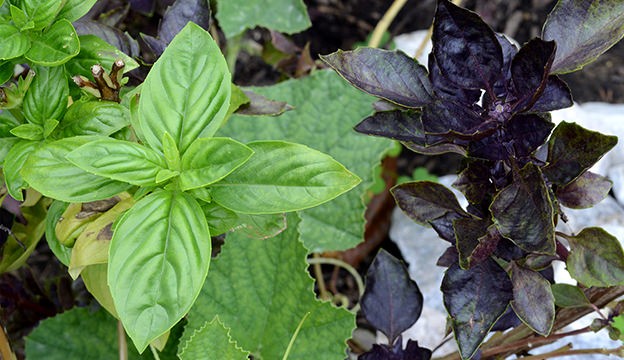There is a wide range of basil varieties and species that surprise with special taste, from mild to anise-like to spicy. We present the most popular varieties and give tips on care. Thus, there are many basil varieties, suitable for different dishes. Many of the varieties presented are also more resistant than the well-known Genovese basil. The most important basil varieties are presented here.
Contents
Botanical information
Basil (Ocimum) belongs to the labiates family. The name ‘basil’ is derived from the Greek word ‘basilikos’, royal. The origin of the plant can no longer be determined. However, it is certain that basil originates from the warm regions of Africa and Southeast Asia. From this, its requirements for location and care can also be deduced.
Most basil varieties bloom white, pink or purple. Their flowers are a real bee magnet and attract butterflies, bees and bumblebees.
Genovese basil (Ocimum basilicum genovese)
This basil is the typical basil for Italian dishes and is at home on many windowsills and balconies in our country. It is an annual and, since it loves warmth and light, it thrives best in the summer months. In sheltered places, Genovese basil grows into a lush bush and lavishly exudes its aromatic fragrance. This basil develops white flowers between June and September. Genovese basil is eaten with tomatoes, pizza or pasta, or made into pesto.
Fine-leaved basil or Greek basil (Ocimum minimum).
Greek basil has small, firm leaves and a spherical, compact habit. It is hardier and easier to care for than Genovese basil. But although it resembles it in taste, it is much milder. It does not play a role in Greek cuisine, but is planted on terraces mainly to repel mosquitoes because of its intense fragrance. It is also used as a holy water sprinkler in the Greek Orthodox Church.
Red-leaved basil
The red varieties of basil originated in Japan. The active ingredient anthocyanin provides the red leaf color and is also responsible for the high vitamin C content. The mostly annual varieties reach a height of up to 60 cm. Flower colors range from light pink to dark purple.
Red basil usually tastes a bit more tart than Genovese basil, but is used similarly.
For example, a basil with red leaves is the ‘Dark Opal’ variety (Ocimum basilicum “dark opal”). Dark Opal tastes similar to Genovese basil, but not as intense. With its purple leaves and pretty pink flowers that attract lots of bees, it looks very decorative in a plant pot or bed.
Magic Blue (Ocimum basilicum “Magic Blue”) is similar to Dark Opal. Like it, it has bright purple leaves and purple flowers. This plant is quite hardy, its stems lignifying easily. The aromatic leaves taste great in salads or with tomatoes.
‘Chianti’, ‘Moulin Rouge’ and ‘Purple Delight’ are other examples of red-leaved basil species.
Thai basil
The name Thai basil is used to refer to various species of basil: Horapa, Maengla, and Krapao are the best known. All three are used in Asian cuisine.
Horapa (Ocimum basilicum var. Thyrsiflora), also called sweet basil, has a slight anise aroma and is used in Thailand to flavor soups and sauces. In this process, it is added to the food at the last minute. In Vietnam, it is usually served raw with dishes. Horapa basil has green leaves with reddish stems and clearly visible veins.
Maengla (Ocimum citriodorum) is also called lemon basil because of its taste. Its leaves resemble Horapa basil, but are lighter in color and slightly hairy. Maengla basil is only ever used raw to flavor fish and soups and to flavor drinks.
Kaprao (Ocimum tenuiflorum), also called Indian basil, is used to flavor roasted meats and stir-fry dishes. Its leaves smell of cloves and allspice. The aroma develops more intensely when the leaves are slightly heated. Therefore, they are added to the dishes and cooked a few minutes before serving. The leaves of Kaprao basil are larger than those of other basil varieties.
African basil
In Africa, basil finds ideal growing conditions due to the climatic conditions. Therefore, a variety of wild species can be found on the continent. African varieties are perennial plants, which in our latitudes they must be overwintered frost-free. An example of African basil is the green-leaved African basil (Ocimum kilimanjaricum). Native to the Kilimanjaro region, it is perennial and tends to become woody. With its aroma reminiscent of camphor, it is very different in taste from the basil species already mentioned. It is used to enhance soups, fish and tomato dishes.
Use basil
Basil tastes best when the leaves are eaten raw. It is important to pluck the leaves as fresh as possible, as they lose their aroma quickly. Therefore, basil should also not be dried. However, as a pesto, finely chopped in olive oil, it retains its incomparable aroma.
Growing and harvesting basil
When caring for basil, you must be guided by the needs of the plant. The most important ones are that basil loves light and warmth.
Therefore, it grows best in a sunny south window in the room or during the summer in a sunny place in the garden or balcony.
The location of basil should be protected, because the plant does not like wind or heavy rain.
It grows best in a container or raised bed, as slugs also appreciate the tender leaves of the herb.
When harvesting, always trim the stems just above a leaf axil. The basil will branch out again and you can harvest again.


